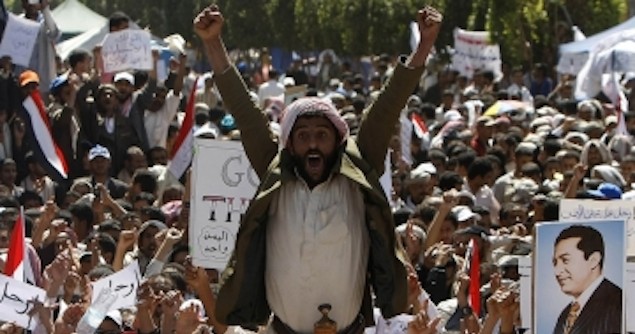Yemen on the Brink

Following reports of a ceasefire agreement reached Sunday 21 September between the Houthis—a Shia rebel group—and the Yemeni government, the country is reported to have turned from the brink of civil war. The much-needed talk of a peace deal came after three days of intense fighting in Sana’a, the nation’s capital, where the Houthi rebels launched a shelling campaign and captured almost every major government building, including the Military General Command and Yemen’s state TV headquarters.
Among circulating questions on the details and authenticity of the peace agreement, a statement by the United Nations’ envoy to Yemen, Jamal Benomar, described it as “a national document that will advance the path of peaceful change, and will lay the foundations for a national partnership and for security and stability.
The announcement came late Saturday after several failed attempts to broker a much-needed peace deal amid escalating tensions. On Friday, Benomar left the northern city of Sa’dah after attempting to mediate an agreement to put an end to elevated levels of violence and tension in the country between the Shia rebel group and government troops. The proposed deal was set to accommodate rebels’ demands for the formation of a new government that would grant greater political representation as well as lowering fuel prices in return for them withdrawing forces, dismantling protest camps and halting civil disobedience. After multiple rounds of failed peace deals, Yemen appears to have broken into a state of sectarian chaos from all sides.
The latest tensions saw rebels flood the capital, reportedly bringing violence to new levels since last Friday. After days of intense fighting in the outskirts of the city, Sana’a is reportedly reminiscent of a war zone divided among Sunni and Houthi lines. With warplanes clustering the skyline, clashes outside of the Presidential Palace and international airlines suspending flights in and out of the capital, the rapidly rising level of violence suggests that it may potentially turn into a full-scale civil war; possibly marking the worst in the region since the Arab Spring revolts of 2011.
However, this recent strain of violence is not new.
The Houthis, a minority group affiliated with the Zaidi sect of Shia Islam in Sunni Yemen, have stepped up protests against the Yemeni government since late July. Following a televised speech on 17 August by the Houthi leader Abdulmalek al-Houthi demanding the reinstatement of fuel subsidies, among other things, and warning against consequences if the government failed to deliver, the Shia group moved its protests to the fringes of the capital. Escalating tensions came after a gradually increasing sense of government-induced marginalisation post-2011 when the Shia group signed a peace deal with the government.
Having gained considerable territory and influence since then, Houthis have turned from peaceful protests and public rallies to aggression in channelling their political frustrations and economic despair; this time in the shape of a grand-scale shelling campaign in the capital. Armed with general public discontent and heavy weaponry, Houthi aggression calling for greater political rights, changeover of an allegedly corrupt government and an end to fuel price hikes has gained both military and popular momentum. No longer on the peripheries of Yemen’s political scene, Houthis are rapidly emerging as one of the strongest armed groups in the country and possibly the whole region.
This is in the context of a government struggling for legitimacy. With the prospects of a cohesive peace process bleak, Yemen’s sectarian grievances are challenging an entity that resembles more a failed state than an intact nation. More than ever, Yemeni president, Abd-Rabbu Mansour Hadi is fading into obsolescence. With a power base in the south and little control over northern grievances, a fragmented military with Shiite commanders that might turn against him if a Houthi crackdown were ordered and growing Sunni frustration arising from economic and territorial grievances, President Hadi is perceived as weak and corrupt by a progressively disgruntled electorate.
With the leadership caught at a strategic impasse, sectarian tensions dominate Yemen. The country is faced with another rebellion in Aden in the south, perpetrated by a secessionist Southern Movement; as well as independent local militants clashing with the al-Qaeda in the Arabian Peninsula (AQAP) insurgency in the south, which gained rigour after the 2011 Revolution and is now armed with a bid to set up an Islamic Emirate in the eastern province of Hadramout.
The recent escalation of armed fighting between the Houthis and government forces also presents a threat in opening up a dangerous power vacuum in the south to be seized by AQAP militants seeking territorial expansion.
In the toxic environment in which Yemen finds itself post-revolution, the northern Shia insurgency—once a peripheral inconvenience—is quickly becoming the push-factor of the nation’s descent into chaos. Given that negotiations between the rebel group and the government are ongoing, with the Houthis demanding fuel prices to go down by 25 per cent as well as an equal number of cabinet posts in the government as other parliamentary blocs, it remains unclear whether Yemen’s national integrity will survive another blow.
Hale Yildiz is a current research intern and editor of Australian Outlook at the AIIA National Office. She can be reached at australianoutlook@20.185.176.227.